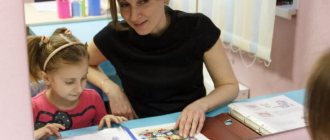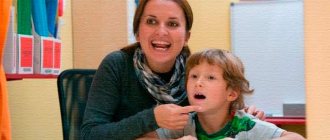- home
- Speech disorders
With normal speech development, children aged 4-5 years freely use phrasal speech, construct complex sentences, and have more than 3,000 thousand words in their active vocabulary. After 5 years, sound pronunciation is fully formed. These are average standards. If by the age of 2-3 the baby does not speak at all or uses only a few words to communicate with others, grossly violates the grammatical and phonetic rules of the Russian language, then the parents may suspect that he has level 1 OHP. What it is, how to diagnose it and treat it correctly, we will tell you in our article.
Definition
General speech underdevelopment of level 1 is a severe form of speech defect, typical for “speechless” children with a normal level of intelligence and healthy hearing. Such a child exhibits violations of all components of the language system, and non-compliance with language norms is very gross. Children with level 1 ODD violate the rules of phonetics, grammar, vocabulary, and phonetics. Their speech is incoherent, similar to babbling, or it is almost absent. This disease can be detected and diagnosed from 3-4 years of age.
The term “general speech underdevelopment” (GSD) was introduced into science by the Soviet teacher, psychologist, researcher at the Institute of Defectology of the RSFSR, Research Institute of Defectology - Rosa Evgenievna Levina.
She developed the concept of general underdevelopment of speech in the 1960s - this became the main merit of R. E. Levina in science and pedagogy, on the basis of this work she defended her doctoral dissertation.
After a long study of younger preschoolers, Levina came to the conclusion that it is speech underdevelopment that often leads to failure in school. She developed a method of correctional work for OPD levels 1-3, tested it in practice and proved its effectiveness.
The characteristics of level 1 OHP are described in detail in the scientific work of R. E. Levina “Fundamentals of the theory and practice of speech therapy,” published in 1967. This book is useful for practicing speech therapists, psychologists, and speech pathologists.
“WORKING WITH CHILDREN WITH LEVEL 1 SEN”
WORKING WITH CHILDREN WITH LEVEL 1 SEN
Speech therapy work with children of the first level of speech development
Level I children are characterized by babbling speech or its absence. The active vocabulary of these children consists of babbling words, onomatopoeia and common words (mom, dad, give, na). The structure of these words is often broken. The passive vocabulary is somewhat wider than the active one. There is no phrase at this level. Children express their desires in separate words that are grammatically unrelated to each other, for example: “Tata aunty atyati” (Tanya wants to sled), etc.
Children of the first level also find it difficult to understand grammatical forms; they do not distinguish between the number and gender of a noun, an adjective, and some case forms. Children rely mainly on the lexical rather than the grammatical meaning of a word.
This group of children is characterized by immaturity of visual and auditory attention and memory. Attention is unstable, performance is low. Taking all this into account, correctional work with this category of children is structured as follows.
At the first stage, the speech therapist works on the dictionary, clarifies and expands the passive and active vocabulary of children. The words that the speech therapist selects must be understandable to children and easy to pronounce. These can be nouns, adjectives, pronouns, verbs. First, the easiest words in their structure are practiced: two-syllable words with open repeating syllables, such as mom, dad, baba, Tata, then two-syllable words with emphasis on the first and second syllables, for example: Pata, Vova, Olya, Katya, vata, etc. ... then monosyllabic words like: house, ball, give, drink, etc. Gradually, the structure of the word becomes more complicated, three-syllables with straight, open syllables (car, dog, blue, etc.) and two-syllables with a combination of consonants (cat, spoon, bear, doll, big, sitting, eating, etc.). As soon as the child has even the slightest vocabulary, the speech therapist can begin working on the phrase. At first it will be a simple two-part sentence like: This is mom. Here's mom. Mom is sitting. My mother then offers a sentence with an address: Aunt, give me the ball with a demonstrative pronoun: This is a small ball.
This big ball is common with a direct object: Lena is carrying a bear, etc.
Methods of speech therapy work for motor alalia (1st level OHP)
Speech therapy work with non-speaking children is built in stages. Effectiveness depends on the goal setting, the validity of the speech skills that the child must master at this stage, the effectiveness of means, methods of speech therapy.
Speech therapy work with children with motor alalia is based on the ontogenetic sequence of speech development according to A. N. Gvozdev:
one word sentence
sentence from root words
first forms of words
mastering inflections
mastering prepositions
the presence of extensive phrasal speech with problems in the formation of vocabulary, grammar, phonetics.
The first stage of speech therapy work corresponds to level 1 of OHP and lasts approximately until the appearance of phrasal speech.
Main goals:
Formation of the motivational basis of speech activity
Education of the child’s speech and mental productive activity
Development of impressive speech (perception and understanding of speech)
Formation of an active vocabulary that is understandable and reproducible
Formation of initial communication skills in various situations (maintaining basic dialogue)
Improving non-speech processes.
Key attention is paid to the semantic side of speech; incorrect pronunciation is acceptable. The initial step is to establish emotional contact with the child and create a friendly atmosphere.
Areas of work:
Improving the understanding of spoken speech. It is necessary to provide knowledge about verb forms, their differentiation - to increase understanding to the predicative level
The expansion of the impressive vocabulary is carried out on the lexical topics “Toys”, “Parts of the body and face”, “Household items”, “Animals”. Basic techniques of work - showing, demonstrating, instruction, question (after getting acquainted with the subject: “Show me where.”)
The passive verbal dictionary should consist of names of actions that are performed by the child’s loved ones and by himself. We make sure to provide a connection – verb + noun. We learn to differentiate elementary grammatical forms, understanding the issues of indirect cases.
Improving non-speech processes by performing various non-verbal (without using words) tasks:
Formation of contrasting values (large, small, medium)
Teaching orientation in space, and later in the seasons
The concept of primary colors
Concept of form
Auditory attention and perception (where is the bell hidden?)
Improving memory (which did not happen)
Mental operations (fourth wheel, cut pictures, Seguin boards)
Formation of an accessible active dictionary. Onomatopoeia and amorphous words are evoked. It is necessary to combine words into a phrase at the first opportunity.
The result of the first stage: expanding your horizons and ideas about the world around you. The ability to maintain a dialogue at an accessible level, the first attempts to combine words, mastery of a basic active dictionary.
Planning speech therapy sessions
%img src=»/images/ramka-vp.gif>
Long-term plan for working with children of the 1st level of OHP.
Zhuzhma A.N. teacher-speech therapist at MBDOU kindergarten No. 18 in the city of Krymsk, Krasnodar Territory (20 years of teaching experience).
Development of speech understanding,
Development of general and fine motor skills, imitation, constructive praxis. Development of visual attention and perception.
To form attention to non-speech sounds and develop auditory perception - the game “Where is it thundering?”
Overcome speech negativism, evoke a desire to speak.
Learn to repeat after an adult words denoting people close to the child (mom, dad, baba, aunt, uncle, lalya).
Develop the ability to answer the question who is this?
To develop correct speech diaphragmatic breathing, correct articulation of vowel sounds A, U, to overcome a strong attack of the voice - exercise “Listen and repeat”:
Ah-ah-ah! - mother rocks baby
Wow! Wow! - baby cries
Oooh! - the old grandmother moans
Develop a strong, smooth exhalation, activate the labial muscles - the “Musical Bubble” breathing exercise.
Learn to pronounce words of the first type of syllabic structure - two-syllable words made of open syllables, exercise “Find out who it is?”
Correctional work with preschool children with special needs levels I, II, III
From the authors
It is known that a person only becomes a full citizen of a given society when he interacts with its other members. When the cultural experience accumulated by previous generations is assimilated within an individual family and the entire nation, when this experience is fully exchanged, when interpersonal contacts are established.
All this would be impossible without speech. Its role in the development of a child as a person cannot be overestimated. Speech contributes to the formation of intelligence, increases cognitive activity, and significantly expands the horizons of a small person. The task of adults - parents and teachers - is to help him master oral (and written) speech.
Unfortunately, the number of children with speech underdevelopment has recently increased. Speech disorders complicate communication, negatively affect mental activity, lead to changes in the emotional sphere of the child, limit the acquisition of conceptual meanings and speech patterns, and interfere with the acquisition of literacy.
The specificity of correctional work in a preschool institution lies in the formation of conceptual thinking and expansion of the cognitive capabilities of pupils. Children can navigate the world around them, gaining ideas about nature and society. The child enriches his vocabulary and constructs grammatically correct phrases when expressing a certain thought.
Finally, skillfully constructed correctional work contributes to the formation of a normal mental life of the child.
The proposed manual consists of four sections written by different authors, under the general editorship of Ph.D. ped. Sciences, Associate Professor of KPSU P.N. Loseva. Sections “Correctional work with preschool children with special needs of levels I, II, III” and “Organization of a comprehensive support service for a child with persistent specific speech disorders and severe mental disorders” were compiled by the head of preschool educational institution No. 249 in Krasnoyarsk V.I. Chernykh and speech therapist of the highest qualification category A.G. Baranova. The authors of the section “Formation of emotional vocabulary in preschool children with ODD in the process of correctional work” are teacher-speech therapist of Preschool Educational Institution 249 in Krasnoyarsk E.P. Timoshenko and Ph.D. ped. Sciences, Associate Professor KPSU P.N. Losev.
The authors hope that this book will help speech therapists and preschool teachers in their work, which is so necessary in the formation of a physically and psychologically healthy person.
Characteristics of groups of children with ODD levels I, II, III
The speech group “General speech underdevelopment of levels I, II, III” consists of children with disorders in which the formation of all components of the speech system is impaired: phonetics, vocabulary, grammar related to its sound and semantic side with normal hearing and intelligence.
For the first time, a theoretical basis for general speech underdevelopment was formulated by a group of scientists from the Academy of Pedagogical Sciences of the USSR under the leadership of R.E. Levina. Deviations in the formation of speech began to be considered as developmental disorders that occur according to the laws of the structure of higher mental functions.
General speech underdevelopment in its pure form is extremely rare: only 30% of children in the group show signs of ODD without impairment of neuropsychic activity. The rest have both psychoneurological and somatic problems.
Inferior speech activity leaves an imprint on the formation of the sensory, intellectual and affective-volitional environment. The connection between speech impairment and other aspects of mental development determines the specific features of the development of thinking.
Having, in general, complete prerequisites for mastering mental operations, children lag behind in the development of verbal and logical thinking, without special training they have difficulty mastering analysis and synthesis, comparison and generalization.
Primary speech pathology inhibits the formation of potentially intact mental abilities, preventing the formation of speech intelligence.
Children in this group have insufficient stability of attention and limited possibilities for its distribution. While logical memory is relatively intact, verbal memory is reduced and memorization productivity suffers. Children forget complex tasks and the sequence of their completion, for example, when moving according to verbal instructions: jumping on the right and left leg, rhythmic movements to music. There is insufficient coordination of the fingers and underdevelopment of fine motor skills. Examining children with general speech underdevelopment, a psychoneurologist gives them an additional diagnosis - delayed mental or intellectual development.
In this speech group, the child begins to speak later than his peers; a poor vocabulary, agrammatism, and defects in pronunciation and phoneme formation are noted. Speech underdevelopment can be expressed to varying degrees: from the complete absence of speech or babbling to its expanded state, but with elements of phonetic and lexico-grammatical underdevelopment. It is necessary to work on speech comprehensively, since all components of the language system are impaired: sound pronunciation, lexical and grammatical design, coherent speech, phonetic and phonemic hearing.
The organization of correctional and educational work with such children requires not only a close relationship between all employees of the preschool educational institution (educators, speech therapists, psychologists, managers of physical and musical development), but also their interaction with medical specialists, especially a neurologist.
General speech underdevelopment is divided into three levels.
I level
Active vocabulary is in its infancy. It consists of onomatopoeia, babble and only a small number of common words, the meanings of which are unstable and undifferentiated.
Passive vocabulary is wider than active, but understanding outside the situation is very limited. Phrasal speech is almost completely absent.
The ability to reproduce the sound and syllabic structure of a word has not yet been formed. Children are at the level of babbling speech and need a lot of preparatory work: establishing contact with the child, developing visual and auditory perception and memory, the ability to navigate in space, and fine motor skills of the hands.
Level II
Children's speech abilities increase significantly. Communication is carried out not only with the help of gestures, accompanied by babbling fragments of words, but also through fairly constant, although very phonemically and grammatically distorted, speech means.
The active vocabulary is expanded not only by nouns and verbs, but also by some adjectives (qualitative) and adverbs.
Speech is replenished with individual forms of inflection. Children are observed trying to change nouns by gender, number and case, and verbs by tense, but this is not always successful.
Children begin to use phrases.
Understanding of speech improves, active and passive vocabulary expands, and understanding of some simple grammatical forms arises.
Pronunciation of sounds and words is very impaired. Children are not yet prepared to master sound analysis and synthesis.
Level III
Against the background of relatively detailed speech, inaccuracies in the use of everyday vocabulary are noted. Children's active vocabulary is dominated by nouns and verbs. There are few words that characterize the quality, signs, states of objects and actions, as well as methods of action. A large number of errors are observed in the use of simple prepositions against the background of the absence of their complex types in speech.
There is insufficient development of the grammatical forms of the language: errors in case endings, confusion of tense and aspectual forms of verbs, errors in agreement and control. Children almost never use word formation methods.
In active speech, predominantly simple sentences without secondary members are used. There are great difficulties in constructing complex and complex sentences.
Most children still have deficiencies in the pronunciation of sounds and a violation of the structure of words, which creates great difficulties in mastering sound analysis and synthesis.
Understanding of everyday speech is generally good, but sometimes ignorance of individual words and expressions, confusion of semantic meanings of words that are similar in sound, and unsteady mastery of many grammatical forms are revealed.
Correctional work with preschool children with special needs levels I, II, III
This section defines the main tasks, outlines the directions and content of the work, provides sample games and tasks, and selects verbal lexical material for retellings, descriptions, dramatization games and dialogues. All this allows us to establish a close relationship in the work of the speech therapist and the teacher, to ensure an individually differentiated approach to working with children
Causes
The etiology of level 1 OHP in children is always associated with harmful effects on the baby’s body during the prenatal and postnatal period. The formation of correct speech and its development according to age are adversely affected by:
- Toxicosis in the expectant mother
- Fetal hypoxia during pregnancy and childbirth
- Presence of Rh conflict between fetus and mother
- Head injuries
- Prematurity
- Infections
- CNS damage
- Encephalopathy
- Primary defects: alalia, aphasia, dysarthria, rhinolalia
In a small number of children, type 1 OHP becomes the result of pedagogical neglect, social isolation, lack of verbal communication, and emotional tension in the family.
Causes
There are several groups of reasons under the influence of which these disorders can occur:
- Pathologies in intrauterine development - toxicosis in the mother in the early stages (when the baby’s nervous system is being formed and formed), various diseases suffered by the mother during the first trimester of pregnancy (viruses and infectious diseases are especially dangerous in the first trimester of pregnancy), Rh conflict.
- Birth pathology - traumatic brain injury, suffocation by the umbilical cord (asphyxia), as a result of which the newborn experiences oxygen starvation, and this, in turn, negatively affects not only the speech centers of the cerebral cortex, but also all other organs and systems.
- Diseases suffered by the child in the first year of life - viral, infectious, various injuries.
- Hereditary factor.
- Negative influence of the environment - the absence or insufficiency of a correctly speaking environment for the child - speech disorders in parents, father and mother with hearing loss (in hearing children), various traumatic situations, frequent and long-term hospitalizations of children.
Pathogenesis
General speech underdevelopment develops in children against the background of other primary defects. This is aphasia, alalia, when a child’s active speech and its understanding are grossly upset. In other cases, OHP develops due to anatomical defects of the speech apparatus - rhinolalia, dysarthria. With such defects, sound pronunciation, syllabic composition, vocabulary and grammar of speech disintegrate.
According to researchers, preschoolers with ODD lag behind their peers not only in speech indicators, but also intellectually and physically. This is due to the timing of speech maturation, the ability to learn new things, and socialize.
Experts to contact
Often, speech disorders are accompanied by neurological pathology, which is expressed by a slow rate of maturation of the nervous system. Therefore, a competent specialist will prescribe special medications that will promote and stimulate its ripening. Accordingly, a neurologist will treat the little patient.
Some children experience psychological difficulties when their words, phrases and sentences are incomprehensible to peers and family. Therefore, in order to cope with them and not lead the child to logophobia (fear of speaking), a child psychologist gets involved. In addition, preschoolers with ODD suffer from higher mental functions that are closely related to speech: memory, attention, thinking.
Speech therapist. The main role in overcoming the above disorders is assigned to this specialist, who will conduct a competent diagnosis, determine the degree of speech development, and outline a lesson plan, goals and objectives. With level 1 OSD, an individual approach to each individual child is necessary, since speech disorders are diverse. The ideal solution would be for the child to attend a speech therapy kindergarten.
Signs
Children with this diagnosis are extremely limited in communication. They use several words, onomatopoeia, facial expressions and gestures to convey thoughts and express requests. At the same time, word forms are greatly distorted, sounds are pronounced defectively, and syllables are unclear. One word is used to name several objects or actions. For example, bai means sleep, bed, fatigue.
Level 1 OHP in a child is characterized by several more signs:
- Words are used in their root form, there are no inflections.
- There is no difference between singular and plural.
- Prepositions are not used.
- The child does not distinguish the gender of nouns and past tense verbs.
- The syllable structure is not perceived.
- In everyday life, a limited set of words and memorized phrases are used, which are repeated many times.
- Complex words are reduced to 1-2 syllables.
- Some children use babbling sentences to express thoughts, while the words are distorted and combined without prepositions or inflections. For example, bibi tutu (the car has driven away), gai ball (playing ball).
- When composing a story, description of an event, or a picture, preschoolers reduce sentences to one word, or at best two. "Papa Tutu. Bibi. Gave." This means: dad left by car, and I was waiting for him.
- The passive vocabulary is much richer than the active one. Researchers of the defect claim that children with ODD understand everything, but cannot express it.
- Understanding speech outside of a situation is difficult. When addressing or requesting a child, an image of an event or object in the picture is required.
- If level 1 ODD is detected in a child at 3-4 years of age, correction is carried out competently, and by 7-8 years of age the disorder can be completely eliminated.
Characteristic
Children with level 1 ODD up to 2-3 years of age are almost no different from their peers in terms of their psychological portrait. Parents do not notice speech defects, attributing babbling and crumpled phrases to the age characteristics of the baby.
When a child is forced to socialize and leave the family circle, the problem becomes more obvious. A preschooler has difficulties with communication, as he grows up his mental abilities are inhibited, preparation for the first grade and studying at school are difficult. If a child is critical of a speech defect from an early age, he withdraws into himself and can become aggressive and unsociable. Self-isolation from communication aggravates the child’s psychological state.
Thus, preschoolers with level 1 OHP can be characterized, from a psychological point of view, as follows:
- Increased anxiety.
- Low self-esteem.
- They perceive failure acutely, although they strive to achieve success in any endeavor.
- It is easier for them to express anger, joy, and resentment through facial expressions and gestures than through long statements.
- The interactive function suffers when building communication.
- The focus of adults on the child’s lack of speech increases the child’s fears, so in the presence of strangers, demanding teachers and parents, they are tense and cannot fully grasp the content of educational material.
- Emotional experiences are stable and intense.
Speech therapist Olga Bazhina, an expert on our website, has prepared a psychological and pedagogical description of children with general speech underdevelopment:
Psychological and pedagogical characteristics of children with special needs development
Diagnostics
The diagnosis of level 1 OHP should be made on the basis of a comprehensive examination. The final decision is made by a speech therapist or defectologist. To draw up an accurate picture and study the anamnesis, consultations with the following specialists will be required:
- Neurologist: evaluates the general conditions of the central nervous system.
- Pediatrician: Gives a description of the child's general health from birth to this period.
- Psychologist: assesses the child's sensory, motor and intellectual development.
The speech therapist studies the conclusions of highly specialized doctors and draws up his own picture of the child’s speech state during a conversation with the child and parents. This work is carried out in several stages:
- A child’s development chart is filled out from the parents’ words and descriptions of physical health compiled by a pediatrician. The speech therapist gets to know the preschooler and establishes contact.
- The components of the baby’s speech, motor skills during conversation and play are studied.
- Manifestations of the defect in dynamic observation are clarified. The child is asked questions that require a detailed answer, his level of curiosity and desire to communicate are assessed.
- The syllabic and sound structure of the word, the coherence of speech, and the correctness of grammatical structure are carefully examined.
If a child is diagnosed with general speech underdevelopment of level 1, he needs to be referred to a speech therapy group in a kindergarten. The certificate is issued by the PMPK (psychological-medical-pedagogical commission). The conclusion about referral for speech therapy help in a preschool institution is given on the basis of examinations by specialized specialists, including a speech therapist.
At an advanced stage of mental retardation, level 1-2 OHP, you can apply for disability for a period of 1 year or longer. You need to pass the PMPC, VTEC (medical and labor expert commission). Disability benefits are a good way to pay for the services of a speech pathologist and speech therapist.










